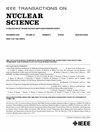On the Applicability of 48V in Positron Annihilation Lifetime Spectroscopy
IF 1.9
3区 工程技术
Q3 ENGINEERING, ELECTRICAL & ELECTRONIC
引用次数: 0
Abstract
The applicability of the 48V isotope as a source of positrons for positron annihilation lifetime spectroscopy (PALS) measurements is discussed. It has been demonstrated that using such a positron source, the classical PALS setup with two detectors does not accurately determine the positron annihilation parameters of the samples being studied. This issue arises when one of the two nuclear gamma rays (of energies of 983 and 1312 keV) that are emitted almost simultaneously with the creation of a positron triggers a start signal, while the other nuclear gamma triggers a stop signal instead of the 511-keV annihilation quanta. These events manifest as prompt coincidences in the start-stop histogram, rendering the analysis of PALS spectra unreliable. To address this problem, a modification to the classical PALS spectrometer was proposed and tested. This modification involved incorporating a logic branch that significantly reduced the undesired prompt coincidences between the 983- and 1312-keV gamma rays. By conducting measurements on a series of samples utilizing 2- and 25-论 48V 在正电子湮没寿命光谱中的适用性
本文讨论了 48V 同位素作为正电子源用于正电子湮灭寿命光谱(PALS)测量的适用性。实验证明,使用这样的正电子源,带有两个探测器的经典 PALS 设置无法准确测定所研究样品的正电子湮灭参数。当几乎与正电子产生同时发射的两束核伽马射线(能量分别为 983 和 1312 千伏安)中的一束触发一个启动信号,而另一束核伽马射线触发一个停止信号,而不是 511 千伏安的湮灭量子时,就会出现这个问题。这些事件在起始-停止直方图中表现为迅速的重合,使 PALS 光谱分析变得不可靠。为了解决这个问题,我们提出并测试了对经典 PALS 光谱仪的改进。这一改进包括加入一个逻辑分支,以显著减少 983-keV 和 1312-keV 伽马射线之间不希望出现的瞬时重合。通过对一系列使用 2 和 25- $\mu $ m 厚的富含 48V 的钛箔的样品进行测量,证明了改变后的设置能够可靠地提取被测样品中正电子湮灭状态的准确信息。
本文章由计算机程序翻译,如有差异,请以英文原文为准。
求助全文
约1分钟内获得全文
求助全文
来源期刊

IEEE Transactions on Nuclear Science
工程技术-工程:电子与电气
CiteScore
3.70
自引率
27.80%
发文量
314
审稿时长
6.2 months
期刊介绍:
The IEEE Transactions on Nuclear Science is a publication of the IEEE Nuclear and Plasma Sciences Society. It is viewed as the primary source of technical information in many of the areas it covers. As judged by JCR impact factor, TNS consistently ranks in the top five journals in the category of Nuclear Science & Technology. It has one of the higher immediacy indices, indicating that the information it publishes is viewed as timely, and has a relatively long citation half-life, indicating that the published information also is viewed as valuable for a number of years.
The IEEE Transactions on Nuclear Science is published bimonthly. Its scope includes all aspects of the theory and application of nuclear science and engineering. It focuses on instrumentation for the detection and measurement of ionizing radiation; particle accelerators and their controls; nuclear medicine and its application; effects of radiation on materials, components, and systems; reactor instrumentation and controls; and measurement of radiation in space.
 求助内容:
求助内容: 应助结果提醒方式:
应助结果提醒方式:


